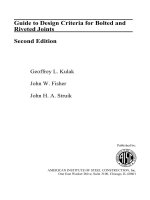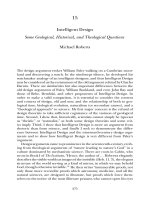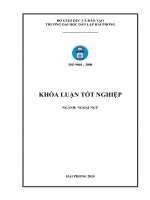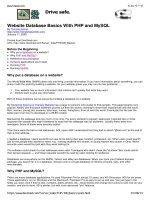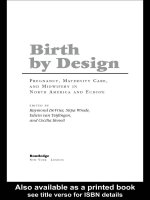Springer balanced website design optimising aesthetics, usability and purpose (springer 2007)
Bạn đang xem bản rút gọn của tài liệu. Xem và tải ngay bản đầy đủ của tài liệu tại đây (15.59 MB, 249 trang )
Balanced Website Design
Dave Lawrence and Soheyla Tavakol
Balanced
Website Design
Optimising Aesthetics, Usability and Purpose
Dave Lawrence, BSc, MA, PhD, PGCertHE
Middlesex University
London
UK
Soheyla Tavakol, BA, MA, PGCertHE,
Middlesex University
London
UK
British Library Cataloguing in Publication Data
A catalogue record for this book is available from the British Library
Library of Congress Control Number: 2006928131
ISBN-10: 1-84628-518-6
ISBN-13: 978-1-84628-518-9
Printed on acid-free paper
© Springer-Verlag London Limited 2007
Whilst we have made considerable efforts to contact all holders of copyright material contained in
this book, we may have failed to locate some of them. Should holders wish to contact the Publisher,
we will be happy to come to some arrangement with them.
Apart from any fair dealing for the purposes of research or private study, or criticism or review, as
permitted under the Copyright, Designs and Patents Act 1988, this publication may only be reproduced,
stored or transmitted, in any form or by any means, with the prior permission in writing of the
publishers, or in the case of reprographic reproduction in accordance with the terms of licences issued by
the Copyright Licensing Agency. Enquiries concerning reproduction outside those terms should be sent
to the publishers.
The use of registered names, trademarks, etc. in this publication does not imply, even in the absence of a
specific statement, that such names are exempt from the relevant laws and regulations and therefore free
for general use.
The publisher makes no representation, express or implied, with regard to the accuracy of the
information contained in this book and cannot accept any legal responsibility or liability for any errors
or omissions that may be made.
987654321
Springer Science+Business Media
springer.com
I dedicate this book to my old dog, Sheber, and my Dad – both
taking a walk in the sky
Dave Lawrence, BSc, PhD, MA, PGCertHE
School of Computing, Middlesex University, London, UK
To my beautiful Bali
Soheyla Tavakol, BA, MA, PGCertHE
School of Computing, Middlesex University, London, UK
Preface
The intention here is to introduce the book by summarising the following
aspects:
•
•
•
•
•
•
Purpose of the book
Main features of the process described (BWD)
Audience targeted
Way the book is to be used
Features of the book website
Author background information
Introduction
This book has been conceived to help you with the process of designing a
website by providing the structured framework of a website design
methodology. It does not give tutorials in technical work, such as HTML
or DHTML, in editing images or other media, in setting up database
processing, or in scripting. Other books do this very well already.
The scope of this book is to explain the context of the website design
activity and to provide easy-to-follow steps in the process of website
design itself supported by a comprehensive set of design documentation
tools. It gives you the structure to apply your technical, analytical, and
creative skills in a very effective and focussed manner. The approach
described in the book is relevant for individual and team designer/
developers and for any type of website envisaged.
vii
viii
Preface
The process described in this book has been given the name ‘Balanced
Website Design’ (BWD), the notion partly being that a holistic balanced
approach is needed for any design and implementation project to be
successful. More specifically, the process described has a substantial
emphasis on balancing the identification of detailed design needs with
the derivation of closely associated design ideas to satisfy those needs.
There is also equal weight given to optimising aesthetic, usability, and
purpose characteristics of the target website. Each of these aspects is
considered important and vital for success.
The process described aims to help you achieve real tangible benefits
in terms of websites that are appropriate and successful – matching
detailed identified needs and desires through careful and thorough
design. New perspectives on website usability and aesthetics are also
explored and discussed in dedicated chapters.
The book describes the background and context of BWD, as well as
working through the implementation of the methodology in detail, step
by step.
Main Features
Balanced Website Design comprises a set of steps that collectively form
a coherent, structured pathway beginning at the inception of project
ideas/request through website implementation. It uses well-proven characteristics of the classic ‘Waterfall’ and prototyping approaches, infuses
important new elements, and applies perspectives that relate specifically
to website design.
Crucially, BWD has a focus on identifying and satisfying specific needs
that relate to what are regarded as the core aspects of website design –
purpose, usability, and aesthetics. The dynamic use of documentation
plays a substantial role in BWD – to assist with the activity of designing as
well as to record the ideas, findings, and decisions made (for later
reflection and iterative design). There is a complete set of specially
designed documentation templates for active use across all of the design
steps – facilitating thoroughness and cohesiveness and promoting consistency across different projects and between project team members.
In the chapters on usability and aesthetics, the material includes an
introduction to the notions of ‘straight’ and ‘curved’ usability, a set of
enhanced usability heuristics, and a fresh analysis of what is meant by the
term ‘aesthetic’. The discussion helps us explore the notion of beauty in
Preface
ix
the complex world of website design and how attention to aesthetics
intertwines with that needed to be given to usability and purpose
functionality.
The process described has built-in flexibility and has user centred
characteristics such as that experienced in ‘soft systems’ approaches, plus
the robustness and rigour found in established structured information
systems methodologies. New ideas and innovative approaches are
moulded into BWD, informed by long experience in web technology, web
design, digital media, graphic design, and general information systems.
Audience Targeted
Balanced Website Design is both for the experienced website developer
and the novice or intermediate developers. Everyone likes an approach
that is
•
•
•
•
•
easy to follow,
gives coherence and structure,
makes for relevant, appropriate, and effective designs,
reduces risks of incompleteness and unsuitability, and
makes the whole process more straightforward and robust.
The format, structure, and scope of the book are designed to be
particularly suitable for use by tutors and students as part of any
undergraduate or pre-graduate course studying or relating to website
design. The process is also appropriate for nonacademic use.
BWD is suitable for individual and team projects and is applicable to
all types and genres of websites. It does, however, require that there be
technical/creative skills available commensurate with the tasks of creating/generating design ideas, building code (and/or using code-generating
software), and preparing the content of the website. The requirements of
the website must be known, or there must be analysis skills available and
access to sources of that information. BWD comprehensively facilitates
and helps secure a strong and relevant website design/implementation,
but the responsibility and power of design creativity are firmly retained
by the analyst/designer/client.
Preface
x
Way the Book Is to Be Used
The book is divided into sections, grouping together chapters dealing
with related activities and topics. Section 1 (Chapters 1–4) is likely to be
used as reference material on the first reading of the book and then
subsequently as periodic refresher material. The section introduces the
main features of BWD and places the process into a wider context. The
chapters on usability and aesthetics provide new insights into these topic
areas to help in the creation of effective designs.
Section 2 describes the details of the methodology steps, so these
chapters (5–8) are likely to be used directly over and over again. Section 3
is essentially a reference section, with technical guidance on software
tools (Chapter 9) and a look at options and issues relating to hosting and
website management (Chapter 10).
At strategic points, the book includes tutorial, seminar, and case study
questions. The tutorial and seminar questions are optional but are especially recommended if you are following an academic course and will
help reinforce understanding. Case study exercises are also provided to
enable you to practice the details of the methodology by applying each
step in turn to your own chosen website development project. Example
uses of the documentation are given within the relevant chapters to help
with understanding and clarity.
The Book’s Website
A website will be available (to coincide with the book’s publication) to
provide resource support for readers and users of the BWD methodology. The website (www.springer.com/1-84628-518-6) will include the
following:
•
•
•
•
•
downloadable copies of design documentation templates,
further case study examples of BWD use,
a designers’ message forum,
BWD hints and tips,
errata and addenda (regarding the book text).
Preface
xi
Author Backgrounds
Dr. Dave Lawrence is a senior lecturer in multimedia web technology and
digital media (Middlesex University, London, UK), leader of a level 2 web
design module for over five years, and has widely published and presented
research in this field and in the related area of interactive design. Following
several years as an information systems analyst/designer in consultancy
organisations, he became an academia-based lecturer, researcher, and
practitioner. His experience in website design goes back to the mid-1990’s
when implementing early ‘live’ Internet video/audio broadcasts. His
current collaborative projects include the design of a conceptual multimedia virtual website and exploring web streaming/digital technology
in interactive arts contexts.
Soheyla Tavakol (senior lecturer, Middlesex University, London, UK)
is a specialist in aesthetics and lectures in website design and digital
media. Experience in the arts and in graphic design, plus a computer
science perspective, contribute to the author’s unique awareness of
aesthetics and design in digital and Web contexts.
Acknowledgments
We thank our families for their assistance and support over the years and
for their patience in allowing us to spend the time living this book.
Thank you to Bob Fields for feedback on the usability chapter and to
Satinder Gill and Colin Tully for inspirations and lifelines.
A special thank you to Filiz Karabey, who kindly allowed us to base
our case study examples on the design of her first-ever website – a
coursework project that was part of a level 2 undergraduate website
design module. We also very much appreciate the various website owners
who allowed us to present screenshots of their webpages in our chapters
discussing usability and aesthetics. Thanks go to Rosebud Productions for
help with book cover imagery.
A big thank you to Helen Callaghan and Catherine Brett of SpringerVerlag for the invitation to write this book and for their unending support
and help in traveling through the complex process of preparing it for
publication. A special thanks to Michael Koy (Senior Production Editor)
and the whole production team at Springer New York for their valuable
contributions to bringing this book to physical fruition.
London, UK
London, UK
Dave Lawrence
Soheyla Tavakol
xiii
Contents
Preface .............................................................................................................. vii
Acknowledgments .......................................................................................... xiii
Section 1: Grounding ......................................................................................... 1
Chapter 1: Balanced Website Design (BWD): The Context Explained ........ 3
Chapter 2: The World of Website Design....................................................... 21
Chapter 3: Website Usability............................................................................ 37
Chapter 4: Aesthetics and Websites................................................................ 59
Section 2: Methodology Process .................................................................... 81
Chapter 5: Requirements – Initial Acquisition ............................................. 83
5.1 Step 1: Project Startup......................................................................85
5.2 Step 2: Time and Task Analysis .....................................................92
5.3 Step 3: Initial Requirements Gathering.........................................97
Chapter 6: Design Needs – Building the Picture......................................... 105
6.1 Step 4: Purpose Aspirations Recognition .................................. 106
6.2 Step 5: Usability and Aesthetic Requirements Recognition ... 113
6.3 Step 6: Review and Reflect (1) ..................................................... 135
Chapter 7: Designing the Solution ................................................................ 141
7.1 Step 7: Technical Options/Selections ......................................... 142
7.2 Step 8: Navigation Design, Screen Layouts, Webpage
Dialogues, Purpose Mapping, and Content Index......................... 150
7.3 Step 9: Review and Reflect (2) ..................................................... 173
Chapter 8: Creating the Website.................................................................... 177
8.1 Step 10: Coding and Building...................................................... 178
xv
xvi
Contents
8.2 Step 11: Website Testing and Evaluation................................... 190
8.3 Step 12: User Evaluation/Review and Reflect (3) ..................... 196
Section 3: Implementation Issues ............................................................... 201
Chapter 9: Software Tools .............................................................................. 203
Chapter 10: Website Hosting and Website Management.......................... 221
Index .................................................................................................................. 233
Section 1: Grounding
Chapter One
Balanced Website Design (BWD):
The Context Explained
Overview
This chapter establishes the need to consider the use of a website design
methodology and describes features desired in an effective methodology. A
process of web design and implementation that follows principles identified
as being necessary in a website design methodology is introduced and
summarised. The process (BWD – Balanced Website Design) has a focus on
balancing detailed design needs with specific design ideas. It adopts a
comprehensive, structured, and stepped approach and optimises the
combination of appropriate aesthetic, usability, and purpose characteristics
by detailed analysis and design.
3
4
Balanced Website Design: Optimising Aesthetics, Usability, and Purpose
Give and Gain
This chapter will take about 40 minutes to read, plus time for the
exercises at the end, and will help you gain the following important
aspects:
•
•
•
an appreciation of why structured design methodologies are
generally useful,
an awareness of features desired in a website design
methodology,
an understanding of the core features and overall structure of
BWD.
You need to read this chapter to bridge the gap between general
awareness of approaches to website design and the details of the
methodology process described later in this book (Section 2). The chapter
establishes a context for considering the details of a website design
methodology and explains the fundamental features and concept of BWD.
Website Design – Historical Perspective
The first webpages, albeit mainly plain text pages, began to be created in
the early 1990s. All design and implementation at that time was,
understandably, on an ad hoc basis, with little in the way of standards yet
established; there was no pattern of acceptable styles and approaches. At
the same time, however, expectations (in terms of content and technical
complexity), audience volumes, and technical possibilities were relatively
limited.
Approaches and techniques were initially simplistic, with webpages
comprising mainly text and with little attention to visual layout design,
detailed usability, and quality dynamic content provision. These ‘design’
attributes were not really an issue of particular concern at the time,
though, as it was still at the experimental technical ‘leading edge’ to create
and use a webpage.
Now, in this fast-developing field, it is approximately a decade later,
and all website designers are faced with massive commercial and
personal expectations, extensive technical and design options, and a
1. Balanced Website Design (BWD): The Context Explained
5
continuing surge of interest and investment in the World Wide Web (the
‘Web’) across all societies and communities.
Rapidly, we have all traveled through a period of dramatic expansion
and explosion in web activity – the Internet is now so prominent in our
lives – for work, fun, and just about anything to do with living.
The Web is proving to be a fantastic breakthrough in this world of
technology and the Internet. It means that now we all have powerful
access to using and developing webpages – providing a great array of
opportunities to individuals and organisations. Every website owner/
developer, on a global basis, is enabled to
•
•
•
•
•
•
•
•
•
•
•
•
express a feeling or an idea,
promote a business,
market a product,
form a community,
help others,
have fun,
encourage exploration,
promote or trigger a new interest,
distribute and/or access information,
experiment with new technology,
be independent,
be global.
Running a good website in this first decade of the 21st century is rather
like running a car in the 1950s and 1960s–it provides a surge of personal
power and possibilities, reaching places that are excitingly new and
previously might have been exclusive or difficult to access. The huge, and
somewhat unique, bonus is that we also inherently benefit from the
collective presence of the myriad of other websites (a bit like individual
mobile phones being much more influential and useful now that general
use and market penetration is so widespread and that the technology for
mobile multimedia is becoming a reality). Websites in the same genre do
compete for attention, however, as do mobile phones and their users.
For almost any idea, activity, or interest, there is a website – each
needing to be designed and created. If you have already faced these tasks,
you will know that however powerful the software that is used to build
the pages, the issue of getting the design ‘right’ can still be a nightmare –
getting it to look and work appropriately. Managing the process and
keeping ‘in control’ is not easy, especially with the massive range of
6 Balanced Website Design: Optimising Aesthetics, Usability, and Purpose
technology and content possibilities, the demands and pressures of the
marketplace, and the idiosyncrasies of the technology and of us as people
using the Web.
For many of the past years, partly due to the relative newness of the
activity of creating websites and partly due to the ease of access to website
creation software, the tendency has been for websites to be designed and
implemented without the adoption of a clear method, and rarely with a
recognised structured methodology. Increasingly, particularly over the
last two or three years, interest has been emerging (in publications and
website design practice) in adopting approaches that have more effectiveness and give the designer more control. The use of a comprehensive
and specifically designed approach to website design is becoming recognised as important.
Without a structured approach, it is likely that the delivered aims and
scope of the site will be incomplete. Intuitive skills and deep experience
can sometimes offset any damage brought about by not adopting a
structured approach, but the risks are high. If there is a lack of detailed
analysis and design, it is unlikely that the style, scope, and content will be
satisfactory. The use of existing websites as guides or templates is a
temptation, and this can perpetuate the use of inappropriate designs –
particularly as the most ‘basic’ designs are often the easiest to reuse by the
nonspecialist designer.
Poorly designed websites, lacking focus and purposeful design, are at best
of minimal use and time wasting and at worst damaging and financially
corrosive. We encourage you to use a structured and methodological
approach to your website design work to help you optimise your designs and
maximise the strength of the actual implementations.
The only reason not to study and take up a structured design approach
is if you are already
•
•
•
entirely happy with the design of your websites,
entirely confident that you have a tried, trusted, and consistent
approach to satisfy all (website) needs, and
entirely satisfied that your site users/clients are impressed by
your websites and the design approach.
The price to be paid for producing a poor website is getting higher and
higher – in terms of missed opportunities, lost revenues, damaged
reputations, etc. The Web is a busy place (with lots of competition), and
1. Balanced Website Design (BWD): The Context Explained
7
web users have ever-rising expectations and can very quickly move to an
alternative website if satisfaction and/or interest is not speedily and
substantially achieved. Potential audiences don’t want to waste time
with sites that appear amateurish or are confusing, uninteresting, or
inappropriate – there are so many others from which to choose, and all
only a few clicks away.
Table 1.1: Desired features of a design methodology
•
•
•
•
•
A conceptual base, which is clearly reflected in
the framework of tasks and the process itself
Demonstrably having a depth and scope that are
comprehensive and vital for successful design and
implementation
Design documentation that triggers creative and
effective design ideas, makes evaluation of
designs and outcome effectiveness sufficiently
objective, helps developer team understanding
and awareness, and eases the task of site
maintenance, growth, and enhancement
Provides/enables template designs and encapsulates good practice for use in subsequent
projects
Encourages professional and academic improvement in the design/implementation process
The term ‘methodology’ is derived from the Greek words meta
(following) and hodos (the way) [1]. A software design methodology is by
definition an organised, documented set of procedures and guidelines for
one or more phases of a software life cycle [2]. A design methodology
should be more than a set of useful tasks, more than a collection of ‘good
advice’ – it must have a conceptual base and a comprehensive set of steps
that are integrated and supported by a documentation process. It is our
view that a good design methodology must include certain general
features (Table 1.1).
8 Balanced Website Design: Optimising Aesthetics, Usability, and Purpose
Website Design – An Emerging Theme
In recent years, several published guidelines and approaches have been
recommended for website designers (e.g., [3], [4], [5], [6]). An analysis of
these publications, and general observational and practitioner experience,
reveal an emerging theme (Table 1.2) for good website design.
Table 1.2: An emerging theme for good website design
•
•
•
•
•
•
•
•
•
•
A website should have a clear overall purpose.
The design and content should reflect the needs
of the target audience and purpose of the site.
The design should aim at creating an appropriate
visual layout and ‘mood’ for the site (the
aesthetics).
Usability is very important – typically targeting
simplicity and clarity.
Adopting a user (audience) centred design
process is effective good practice.
Documentation (diagrammatic and descriptive
format) needs to carried out as part of the
process.
Appropriate navigation styles and relevant
content are crucial characteristics of a website.
Prototyping and iteration are encouraged in the
process.
A structured, stepped approach is favoured.
Testing of designs and implementations must be
carried out.
In this competitive digital world, it is essential to strive for high
website quality – to create websites that satisfy the required purpose(s),
have a magnetic aesthetic, and have a level of usability that makes it a
suitable experience (in ‘operational’ terms). A good website design
methodology must be designed in such a way that it will help the
designer achieve this quality by providing a process to identify detailed
needs, apply appropriately detailed design ideas, and evaluate the
outcomes – all within a structured framework.
1. Balanced Website Design (BWD): The Context Explained
9
This book introduces a framework that is designed to allow accepted
good practice in the details of website design/implementation tasks to be
brought together into a structured process. The methodology is based on
the concept of identifying key design needs (across a combination of
target aesthetic, usability, and purpose characteristics) and balancing
these needs with specific design ideas. A stepped and comprehensive
approach is adopted to optimize the aesthetic, usability, and purpose
characteristics of the target website. An aim of the described process is to
make it generally understandable, approachable, and usable.
Now, don’t run away with the idea that this is easy. It is never going to
be easy to produce something that has to combine creative and technical
flair in an environment as competitive as the Internet. A structured
website design methodology can help, but as with any development
methodology, and with any project type, success requires skills inherent to
the process, innovativeness, discipline, and motivation to take advantage
of the structured guidance.
The cost/benefit ratio of utilising a methodology such as BWD is very
attractive – the extra cost for a project is relatively low (the main
investment items being an instructional book, possibly a few days of
training in process techniques, and thoughtful care taken in the various
stages of a website project). Compare this small outlay with the repeated
and substantial benefits of producing very relevant and effective websites
– benefits enjoyed perhaps on a purely financial basis (e.g., retail or
subscription terms) and/or on the basis of the website providing greater
influence, a richer experience, more enjoyment, and/or increased interest.
Any methodology, by definition, needs some dedicated time to be taken
in its use (because any methodology has rules, a conceptual basis, and
sequences of steps that all need to be understood and followed carefully
before substantial benefits are realised). The time needed should be
regarded as an investment ahead of gaining the long-term benefits of
quality and efficiency.
Balanced Website Design (BWD) – An Overview
Increasingly, the importance of aesthetics and usability in website design
is being recognised by experts, users, and developers [9]. Together with
the intrinsic purpose needs of the website, these aspects form the three
pillars of website design and hence the BWD methodology (Fig. 1.1).
10
Balanced Website Design: Optimising Aesthetics, Usability, and Purpose
Website Design
Methodology
PURPOSE
USABILITY
AESTHETICS
Fig. 1.1: Website design: the three pillars
The precise nature, extent, and specific characteristics desired of each
aspect will depend on the genre and particular aspirations for the website
in question, and the derivation of this information is achieved by
thorough requirements analysis.
BWD has been designed to reinforce and develop the ‘emerging
theme’ suggested in Table 1.2 and satisfy the general design methodology requirements set out in Table 1.1. The methodology encompasses
and progresses the art of good and effective website design by
incorporating additional features with attributes found in traditional
development approaches (see Table 1.3).
Table 1.3: Characteristic features of BWD
•
•
•
•
•
•
•
•
A top-down structured and user-centred approach
Emphasis on website aesthetics, usability, and purpose as
the critical components of any website and website design
A set of design steps that lead and support a developer
from commencement to project completion – adapted
from the well-proven ‘Waterfall’ framework and utilising
checkpoints and iterative prototyping
Adopting a detailed approach of identifying specific needs
and corresponding specific design ideas
Unique documentation notation, styled to encourage a
structured, comprehensive, reusable, and transparent
approach to the design work
An expansion on traditional usability considerations (to
cater more clearly to all types of websites)
Uncovering perspectives on the topic of aesthetics and its
relation to good website design
A comprehensive stepped process and approach that is
easy to follow and easy to understand
1. Balanced Website Design (BWD): The Context Explained
11
In summary, the BWD methodology can be seen as a combination of
traditional and innovative aspects that are underpinned by a structured
stepped process assisted by specially constructed design documentation
techniques (see Fig. 1.2).
BWD Methodology
Traditional Components
•
•
•
•
•
•
•
•
Structured sequence of
steps
Project management
Requirements
gathering
Analysis/design
Building
Testing
Iterative development
and ‘checkpoints’
Use of software tools
and case study
examples
Innovations
•
•
•
•
•
•
•
•
Defining and designing
specifically for website
aesthetics, usability, and
purpose needs
Incorporates enhanced
usability guidelines and
heuristics
Aesthetics – analysed,
categorised, and related
to the website design
process
Accessibility and ‘easy to
follow’ approach
Relevance to all website
genres
Increased awareness of
genre- and audiencerelated website profiles
Specially designed documentation
and process steps
Associated with established good
practice in IS development (topdown approach, iterative, usercentred design)
Fig. 1.2: Elements of BWD
Underpinning
12
Balanced Website Design: Optimising Aesthetics, Usability, and Purpose
If you have experience in the wider field of software development and
methodologies that support general information systems, you will
recognise that certain aspects of BWD relate to aspects of traditional
approaches to design/development. This is so that the process can include
the strengths of such approaches and also because a website is in fact an
information system (IS).
BWD incorporates an adapted ‘waterfall’ [11] approach (where a
development project is broken down into a series of related sequential
steps leading to a conclusion) and the notion of iterative prototyping
(where ideas are tried, tested, and improved in cycles as a project
progresses). When you look closely at each step and the design
documentation, you will see that there is a built-in acute attention to
ascertaining detailed knowledge and understanding about the characteristic website needs, applying creative ideas to satisfy those needs, and
managing the whole process. There are periodic checkpoints to reflect
formally on plans and prototypes to check that requirements are fully and
appropriately satisfied.
All the detail and reasoning of the design is documented, in addition to
the design needs, as the project advances. This helps to increase the quality
of the actual work (helping the designer to carry out the actual design
tasks) and also makes it a transparent process. As indicated in Fig. 1.3, an
additional advantage is that the documented design ideas and analysis of
needs can be reused in, or contribute to, future website design projects.
Website developers and teams who follow and utilise BWD will not
only produce very effective and appropriate websites but there will also
be an important air of consistency – not only within the website itself but
also across and between different website projects. This is extremely
useful in building up a good reputation for quality and helps when teams
and developers move between projects. Consistency in this context means
that the approach across projects, and project teams, is recognisably
similar and that design differences between implemented websites relate
to the differing particular design needs.
Depending on your background and experience, potentially you can
benefit from using a process such as BWD in different ways:
•
Experienced and successful website designers – BWD has the
potential of making your websites more successful, more
appropriate, and more effective. It will increase and sharpen the
focus you already give to understanding detailed and important
website requirements and turning that awareness into real and
1. Balanced Website Design (BWD): The Context Explained
Useful for individual and
small projects, and any
range of project size and
website type
13
Highlights importance of
usability and aesthetics, in
parallel with matching purpose
needs
Consistent and easy-tofollow approach
Balanced Website Design (BWD)
Discrete and seamless
structured steps +
iterative prototyping
Documentation
(Charts/Tables)
guidance/checklist
‘drives’ and
documents design
design transparency
foundation for
maintenance and
enhancement
templates for future
sites
Fig. 1.3: Main BWD features
•
•
specific design characteristics. The design documentation
potentially will speed up future projects due to the potential reuse of good design ideas.
Inexperienced/novice website designers – BWD provides the
comfort and stability of a structured and inspiring environment
that boosts confidence and enables effective results to be achieved
from the very first project.
Development teams – a consistent environment is provided for
design and implementation, which helps with the practical work
